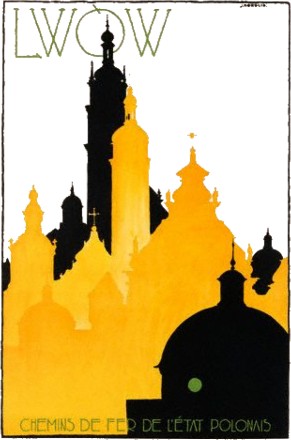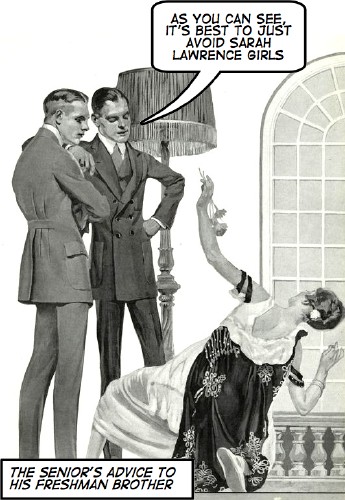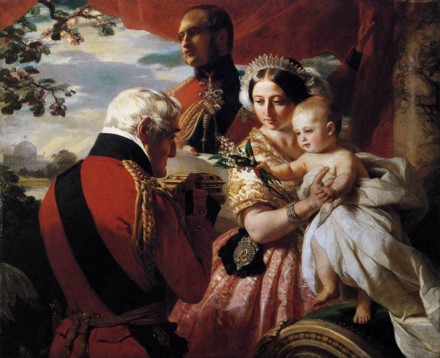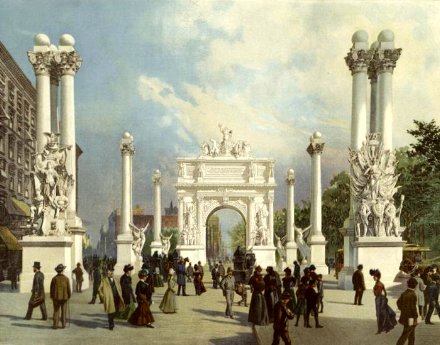Arts & Culture
About Andrew Cusack
 Writer, web designer, etc.; born in New York; educated in Argentina, Scotland, and South Africa; now based in London.
Writer, web designer, etc.; born in New York; educated in Argentina, Scotland, and South Africa; now based in London. read more
News
Blogs
Reviews & Periodicals
Arts & Design
World
France
Mitteleuropa
Knickerbockers
Argentina
The Levant
Africa
Cape of Good Hope
Netherlands
Scandinavia
Québec
India
Muscovy
Germany
Academica
Two Scotsmen
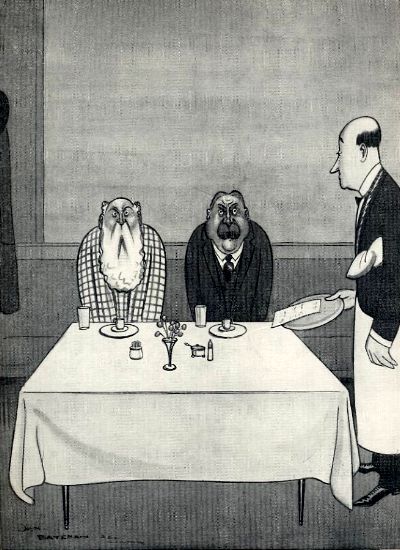
THE ORIGIN OF THE SLOW MOTION PICTURE
Study of two Scotsmen, having dined together, reaching for the bill.
H.M. Bateman
The Haunting Richardsonian
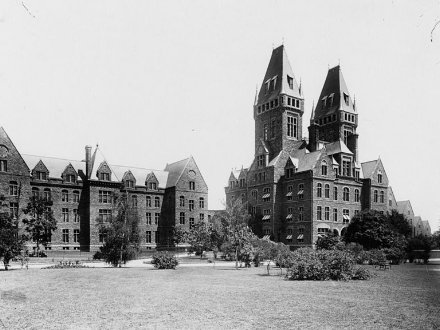
ONE OF THE splendid things about New York is that it’s a land which continually manages to throw up a surprise or two, even to time-hardened devotées of all things knickerbocker such as yours truly. One of my most recent discoveries is the fabulously haunting and impressive Buffalo State Hospital out in the far west of the Empire State.
The magnificent building was built to the design of Henry Hobson Richardson, the progenitor of the eponymous ‘Richardsonian Romanesque’ style, as one of a series of governmental asylums for the insane founded throughout the nineteenth century. Richardson also did a great deal of work on the Capitol in Albany, designing the south façade which, since the construction of Nelson Rockefeller’s Little Brasilia, is now the main façade of the building and was inspired by the Hôtel de Ville in Paris.
Construction on the State Hospital began in 1870, and the central administration block with its two towers and a number of flanking pavilions housing patients were opened in 1880. Interestingly, the towers which so dominate the building are purely decorative and remain unfinished on the interior.

The footprint of the building follows the V-shaped Kirkbride plan, conceived by Pennsylvania’s Dr. Thomas Story Kirkbride in his 1854 opus, On the Construction, Organization and General Arrangements of Hospitals for the Insane which revolutionized care for the mentally unstable in the nineteenth century. The location was a 100-acre parcel of property near the city of Buffalo, and the grounds were landscaped by Frederick Law Olmsted, who designed Central Park with Calvert Vaux.
The grounds originally included farms which helped to feed the patients and staff, but in the 1920’s this land was redeveloped as the Buffalo State College, now the University at Buffalo (State University of New York). The hospital, renamed Buffalo Psychiatric Center, moved out of the Richardsonian complex into a plain, ugly, modern building on the grounds in the 1960’s, leaving the beautiful Victorian structure to rot and ruin.
However recent efforts by Buffalo and New York state officials have led to the replacement of the roof and other work to ensure the continued integrity of the building. The latest plans would have the building serve an educational function under the auspices of the State University next door, an appropriate purpose for this majestic gem of New York architecture.
The Assumption

Nicolas Poussin, The Assumption of the Virgin
Oil on canvas, 22″ x 16″
1650, Musée du Louvre, Paris
Click here for a closer view.
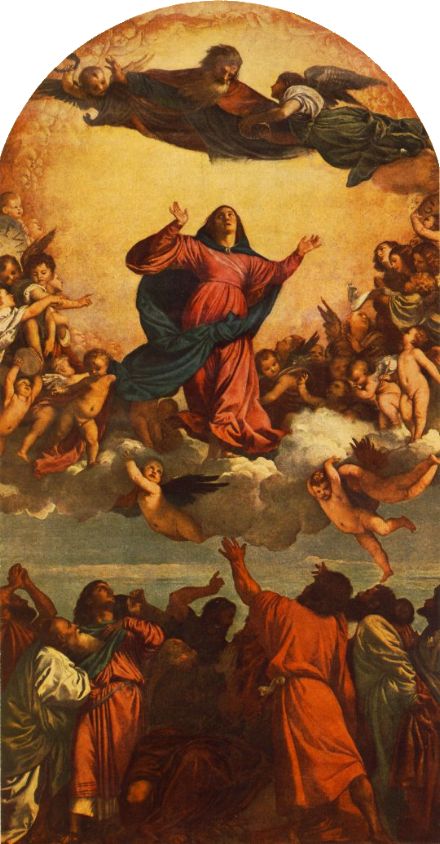
Titian, Assumption of the Virgin
Oil on wood, 272″ x 142″
1516-18, Santa Maria Gloriosa dei Frari, Venice
Peter Simple III
As the Anglo-American intervention in Mesopotamia took place, Peter Simple found he could not avoid the subject. In the first column we present to you today, Peter Simple tells us of another, more dangerous invasion. The second column was written after Defense Secretary Donald Rumsfeld brushed aside the Franco-German opposition to the Second Iraq War, chiding Paris and Berlin as ‘Old Europe’. Of course, the secularist modern republican governments which today rule from Paris and Berlin are about as far from Old Europe as possible, but read on. Peter Simple says it all.
Signs and Portents
January 17, 2003
 We are sometimes asked about our columnar policy in the matter of the proposed American war on Iraq. There is an ongoing discussion about this in the Supreme Columnar Council where the great abbots and nobles meet. They ask: what likely outcome could benefit or damage our columnar interests? Some say one thing, some another; there are as many opinions as men.
We are sometimes asked about our columnar policy in the matter of the proposed American war on Iraq. There is an ongoing discussion about this in the Supreme Columnar Council where the great abbots and nobles meet. They ask: what likely outcome could benefit or damage our columnar interests? Some say one thing, some another; there are as many opinions as men.
Of more immediate concern are rumours of incursions by agents of the American mass-culture, as it is called, into columnar territory. Last week there were reports that infiltrators, most likely seaborne invaders from the vast wastelands of television across the Interpaginal Channel, had appeared in a remote mountain region.
They had installed illegal electro-galvanic machines, distributed cheap “television sets” to a few gullible peasants and begun “broadcasting” seditious and obscene material.
This attempt to defy the fundamental columnar laws against technology did not last long. Sturdy, loyal peasants, wielding the infrangible iron bar of Luddite-Sibthorpian theory, soon smashed the evil machines and chased the interlopers over the border, chanting the old song: “Lift up the stones and expose the technological bandits to the eye of Heaven.”
In another attempt, infiltrators carrying large sums in columnar currency and Maria Theresa dollars, erected an infernal eating house and tried to sell their disgusting fare to the peasants. They even displayed an illicit electro-galvanic sign, “Simpleburgers”, to seduce the peasants from the homely, healthy fare they produce from their own immemorial labours in the fields.
When the victims fell ill from eating this unaccustomed rubbish, a traditional panic set in. Soon the more ignorant took to the roads, wheeling handcarts crammed with pathetic household goods: pots and pans, rocking chairs, bedsteads and icons, with here and there an ancestral grandfather clock, barometer or stringless harp handed down from forgotten bards of old.
A headlong rush towards the Dreaded Eastern Void was averted just in time by greybeard village elders and a few militiamen on leave who knew how to reinforce advice with rougher methods of persuasion. But now worrying supernatural phenomena were seen. A moderate-sized green dragon reading a newspaper was stretched out lazily by the roadside. A plague of frogs invaded a wayside shrine. From abandoned wells voices gave warning in unknown languages, immediately identified by village schoolmasters as “Hittite” or “Old Sorb” – there were few to argue.
Only by continual vigilance can we prevent such incursions, which, as the outer world grows ever more demented and corrupt, can only grow more frequent. What, it may be asked, are the implications for world and other world affairs? Our primary concern, as always, is to defend our borders and uphold our columnar interests. We cannot point out too often that in the event of a serious threat to the paginal balance of power, this column could not and would not stand idly by.
Gone for Ever
“Old Europe”: with this contemptuous phrase, Rumsfeld and his fellow eminences at the White House dismissed French and German opposition to military action against Iraq. Supremely arrogant, confident of a future world order even more repellent than the present, how should they know or care that for some of us Old Europeans the phrase can induce a mood of hopeless longing?
A hundred years ago, Old Europe ruled the world. From its colonies in every continent came tribute which daily enhanced its wealth, convenience and comfort. The old kingdoms and empires were still intact. The Kaiser ruled in Berlin, the Tsar in St Petersburg, the Emperor Franz-Joseph in Vienna, each with his splendid court whose customs and ceremonies seemed made to last for ever.
The civilisation of Europe – the greatest civilisation the world has known – still seemed secure. Its ancient cities, so varied in their beauty and splendour, still held glorious treasuries of art. Its noble landscapes were still unsullied. Its various peoples kept their own historical traditions.
But the death wish fell on Old Europe, and it collapsed in fratricidal war. The Americans arrived to hasten its ruin with their pernicious doctrines of self-determination, equality and perfectability. Mortally wounded, Old Europe staggered on, but could not recover.
Now there is talk of a New Europe. It is a matter not of emperors and kings but of technicians, accountants and businessmen. It may or may not prosper. What do we care, when Old Europe has gone for ever?
Avenida de Mayo, Buenos Aires
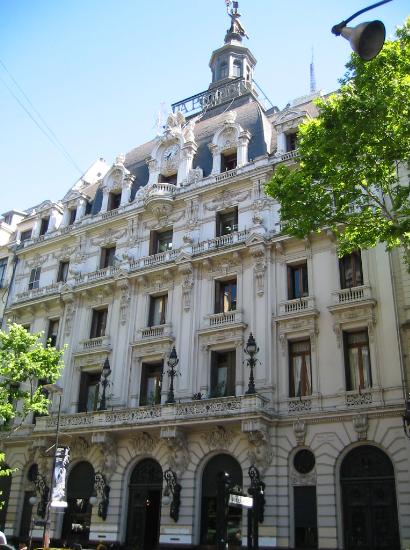
The La Prensa building, formerly home to the newspaper of that name, now the Casa de Cultura.
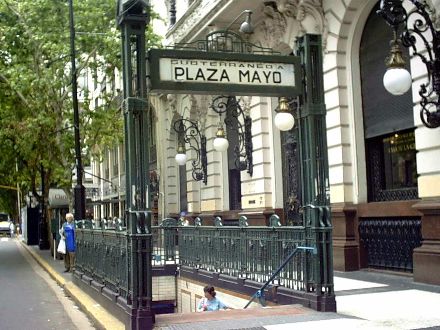
The subte entrance in front of the edificio La Prensa.
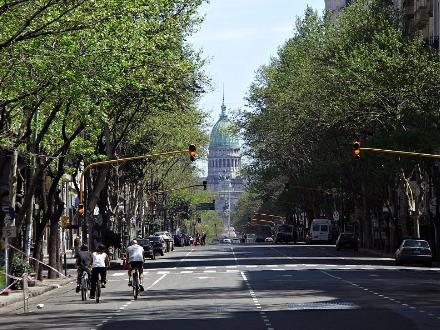
Looking down the Avenida toward the Palacio del Congreso.
New York in Philately
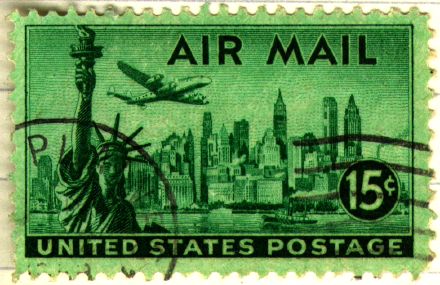
Wandering around the merry old world wide web I stumbled upon these stamps, which I bring to you for your own enjoyment. Above we have the Great Metropolis itself, the island of Manhattan in its swankier days. Below we have a view of the Crown of the Hudson, West Point, with the beautiful Cadet Chapel designed by that American Master, Bertram Grosvenor Goodhue himself, presiding over the campus of the United States Military Academy.
The postage stamp was once a thing of beauty and composition, but it’s heartening to see that some still design beautiful stamps. Just examine Elliott Banfield’s stamp of General Washington, based upon the staute in Union Square. Mr. Banfield believes that the decline in the design of postage stamps is due to a “moral void” most readily shown when the Postal Service unveiled its famous ‘Elvis Stamp’ a few years back.
“Elvis was important in the popular culture, yes,” writes Mr. Banfield. “But how important is the pop culture? Important only to those who can’t see anything higher or better. It’s scary to think that people like that are in charge of public policy. But they are, and the Elvis stamp proves it.”
Hear! Hear!
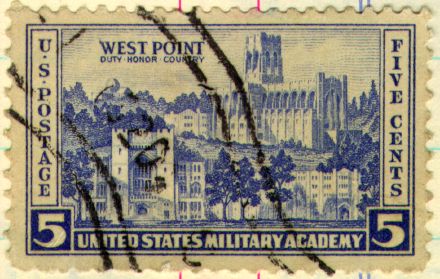
An irrelevant stamp, after the jump.
Can Kid Save This Sinking Ship?
25-Year-Old Buys the Salmon Siren of the Upper East Side
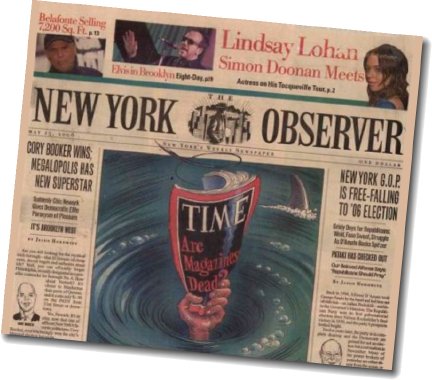
AN NYU LAW  student of just twenty-five years of age has purchased the majority stake in the New York Observer. Jared Kushner (right), son of the currently jailed big-time donor to the New Jersey Democrats Charles Kushner, bought the biggest-piece-of-the-pie off of publisher Arthur Carter, who founded the insouciant weekly printed on salmon-tinted paper back in 1988. No official word on how much money changed hands during the deal, though the Times cites “one person familiar with details of the sale” claiming the amount was nearly $10 million. Carter will maintain a significant say in the paper’s operations, and there are no plans to make any changes to the masthead as of the moment. Earlier in the year Robert de Niro was in talks to buy the Observer through his Tribeca Film Festival operation, but the negotiations fell through.
student of just twenty-five years of age has purchased the majority stake in the New York Observer. Jared Kushner (right), son of the currently jailed big-time donor to the New Jersey Democrats Charles Kushner, bought the biggest-piece-of-the-pie off of publisher Arthur Carter, who founded the insouciant weekly printed on salmon-tinted paper back in 1988. No official word on how much money changed hands during the deal, though the Times cites “one person familiar with details of the sale” claiming the amount was nearly $10 million. Carter will maintain a significant say in the paper’s operations, and there are no plans to make any changes to the masthead as of the moment. Earlier in the year Robert de Niro was in talks to buy the Observer through his Tribeca Film Festival operation, but the negotiations fell through.
The Observer, with a small-but-influential circulation of 55,000, has undergone a miniature transformation recently with the hopes of turning around the current losses of about $2 million a year. The most noticeable of these changes came in May when the paper trimmed over an inch in width, moving from six front-page columns to five and giving it a taller, more narrow appearance. While the thinner size saves on rising newsprint costs it also means diminished space for advertising, and the newspaper lost its easy, leisurely feel, also moving from two sections to one. The Observer has also increased the volume of its internet operations on Observer.com, some might say at the expense of the quality of the printed edition. The new owner, however, will take a back seat in the content of the newspaper while concentrating on improving the bottom line, citing the Observer‘s strong brand despite its current financial woes.
Kushner’s father, a well-known New Jersey real estate developer, was sentenced to a jail term last year after being found guilty of tax evasion, and is well-known for a number of other stunts which do not bear repeating on, er, family-friendly sites such as this. The younger Kushner himself has given over $100,000 to various (Democratic) political outfits since 1992, when he was a mere eleven years of age.
I used to read the Observer often (though not regularly) because it had the most style of all the New York newspapers. While its flighty spirit meant it lacked a certain depth, it still had zing and usually at least a handful of interesting articles each week. The quality of the content began slipping, however, and when I came home to New York I bought one copy while waiting for the train in Grand Central, was completely dissatisfied like the new size and feel, and decided to give it up. I will always have a certain fondness for the Observer though; in the age when Gannett-style corporate monotony is king, it has managed to maintain a certain classic swankiness (epitomised in its reporter-and-skyline emblem) and for that we can be grateful.
The Spectator

Peter Simple II
Traditionalists are very wary of claims that ‘the world has changed’, for we have long memories. We know that the world has only ever truly changed twice: when man first rebelled in the Garden of Eden, and when Christ defeated that rebellion on the Cross of Calvary. Nonetheless, men are fickle and can easily be overwhelmed by events, be they calamitous or felicitous. In his first column after the tragedy of September 11th, Peter Simple mourns the loss while sagaciously pointing out the utter futility of the ‘war on terror’ which had been proclaimed. What took a few years for we foolish knaves to discover, the Grand Old Man was already reminded us merely a week after the terrible attack.
No Change
21 SEPTEMBER 2001
 ONLY a stony-hearted fanatic could have been unmoved by the massacre in America. Yet for us feudal landlords and clerical reactionaries, cranks, conspiracy theorists and luddite peasants, the downfall of the twin towers that symbolised the worldwide empire of imaginary money is not in itself a cause of grief.
ONLY a stony-hearted fanatic could have been unmoved by the massacre in America. Yet for us feudal landlords and clerical reactionaries, cranks, conspiracy theorists and luddite peasants, the downfall of the twin towers that symbolised the worldwide empire of imaginary money is not in itself a cause of grief.
Ever since the atrocity, dense clouds of hysterical rhetoric have been drifting about the world. America is at war, says President Bush. Britain is at war, says Tony Blair, dutifully echoing his master. The whole world is at war, say the “media”. But what enemy is the world at war against? Terrorism!
A war against terrorism is as futile and fatuous as those other fashionable wars, “the war against drugs” and “the war against racism”. You might as well declare war against old age or death.
September 11, the “media” say, was the day that changed the world for ever. But the world has not changed. It is still the same old world, good and bad, that it has always been. As for terrorism and terror, only one thing is certain: we have seen nothing yet.
A month later, a lighter heart returned. Using one of his favourite fictional devices, the Feudal Times and Reactionary Herald, Simple reminds us of the familial bonds which bind Britain and America, and suggests a novel demand to be laid on the Americans’ for support in their time of need.
What the Papers Say
5 OCTOBER 2001
IN A thoughtful leader, The Feudal Times and Reactionary Herald offers an alternative prospect for the world to that of Tony Blair: “Now that our rebellious North American colonists, justifiably enraged by the late atrocities in their country, have put themselves on a war footing, few will doubt that we have a certain family duty to help these wayward but redoubtable people in their time of trouble.
“Few will doubt, however, that the price of our support must be their concurrence with a general settlement in the world: a return to the principles of sanity that were so disastrously overturned by their own revolt and by the even more lamentable events that followed it in France.
“First and foremost, we must assert the superiority of our own European civilisation – a principle left to an Italian politician (whose name escapes us) to enunciate some time ago, to the scorn and derision, needless to say, of the enemies of our civilisation in our own country and abroad.
“We must restore the stability and good government formerly assured by colonial rule in Africa, Asia and South America. A reunited India must again accept the benevolent authority of the Raj. The Chinese Empire, too, must be restored together with its admirable mandarinate.
“In Europe itself, the empires and monarchies which were so lamentably swept away after the First World War, must rise again, ensuring those civilities of diplomacy temporarily replaced by a graceless rabble of ignorant upstarts, low-bred bagmen and radical students. But the price of our support for our rebel colonists in their present trouble must be an end to their present anomalous position which, thanks in part to our own supine policies, has now lasted for more than 200 years.
“We are convinced that the better sort among our rebel colonists would welcome a new declaration of allegiance to Crown and Empire. Sentiment apart, who can doubt that the Empire, newly invigorated by the return of these impetuous but energetic people, would be the dominant power in the world for the foreseeable future, unchallenged by any power or combination of powers that could be brought against it?”
Previously: I: ‘Quiz’ and ‘A Model Planet’
Dawn Eden in the Irish Times

This morning I was browsing the front pages of a few of the world’s leading dailies and came across the Irish Times. I thought to myself “My, that lady bears a striking resemblence to Dawn Eden.” Then I read the headline ‘Chastity Can Make You Happier, Says Author’ and thought to myself “How bizarre! That sounds just like something Dawn would say.” Finally I put two and two together and thought “Crikey! That is Dawn!” C.f. the Dawn Patrol.
Our readers will no doubt recall that Dawn mentioned my comments regarding the Brooklyn Museum’s mauling of their own façade in her Daily News column. More recently she’s written a book and has been buying refrigerators for nuns.
Elsewhere: Superpower: The View from New York – Matt Alderman reports on a night on the town with Dawn Eden including the ever-prescient and incisive wisdom of Andrew Cusack
An Old Boathouse in Spuyten Duyvil
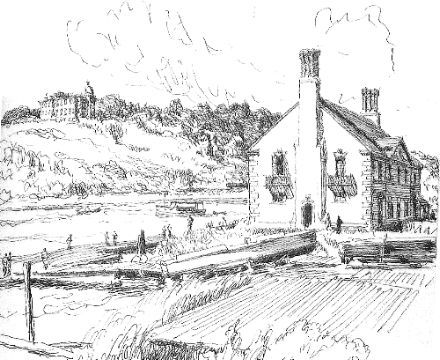
Flipping through an old book called ‘Magical City: Intimate Sketches of New York’, I came upon this sketch of the Gould Boathouse of Columbia University on the Harlem River by Spuyten Duyvil. I had never come across this little building before and had significant doubts as to whether it was still there, but to my pleasant surprise it does. I’m afraid I don’t know much about the boathouse nor its history, but here follows a number of photos and images of it, and of various Columbia boathouses of the past. (more…)
Peter Simple I
The death not all too long ago of Mr. Michael Wharton of the Daily Telegraph‘s Peter Simple column was a great loss to skeptics of modernity in the English-speaking world. We have decided, in little helpings, to bring you a bit of the greatness of Peter Simple on this website so that you may at least have a small taste of what we have lost. Though the column ran for over half a century, we begin with two excerpts from 2000 and 2001 respectively.
Quiz
22 DECEMBER 2000
 HERE are the answers to the annual columnar quiz: (1) the boiling point of Zirconium; (2) the Papal Bull Neo Igitir Sufflaminanda, issued by Pope Innocent the Terrible in 1264; (3) In the slow movement of Mahler’s Symphony No 43 (“the Inexhaustible”), passages for tubular bells are marked con sarcasmo; (4) Douglas Sartre’s Through a Chiltern Window (1906).
HERE are the answers to the annual columnar quiz: (1) the boiling point of Zirconium; (2) the Papal Bull Neo Igitir Sufflaminanda, issued by Pope Innocent the Terrible in 1264; (3) In the slow movement of Mahler’s Symphony No 43 (“the Inexhaustible”), passages for tubular bells are marked con sarcasmo; (4) Douglas Sartre’s Through a Chiltern Window (1906).
(5) We know that Col Palamountain, Dr Znacz, the Rev Ian Yeast and Mrs Library-Smith were playing bridge in the residents’ lounge of the Seaview Hotel at Norquey at 4.25pm, the precise moment when Lord Haversnake’s body was found in the shrubbery by Bates, the head porter.
According to Wendy Kakopoulidis, a temporary Greek waitress, Adam Strongitharm, self-styled ex-commando, para-pharmacist and philanderer, was seen at 4.35 abseiling from the roof of the conservatory after trying unsuccessfully to set it on fire. Therefore the murderer can only have been Miss Bagster.
The questions will appear in the New Year.
A Model Planet
9 FEBRUARY 2001
THE status of Pluto, recognised since its discovery in 1930 as the outermost planet of the solar system, is threatened by American astronomers who maintain that it is not a planet at all but merely the largest of the icy bodies, called the Kuiper Belt, that orbit Neptune.
The American Dr Neil Tyson, whose astronomer’s heart seems to be as warm as Pluto is reputed to be cold, explains how Pluto has changed “from the most puny planet to the King of the Kuiper Belt. I think it is happier that way,” he says consolingly. But an English astronomer, Jacqueline Mitton, says “we have come to know Pluto as a planet and there is no need to downgrade it now”.
The latest probe by the columnar space vehicle “Don Carlos and the Holy Alliance III” sheds a new, balmy light on this quarrel. Daguerreotypes just received from space suggest that Pluto, far from being a miserable ball of ice and rock, is a pleasant little world with many lessons to offer our own.
For such a small planet, it seems to have a remarkable variety of landscape. There are fertile valleys, mountains neither too big nor too small for symmetry, trout streams and salmon rivers, forests plentifully supplied with deer and other game, as well as wolves and bears. Towards the poles there are wild regions to attract adventurous explorers.
A hereditary class of great landowners presides over a russet-cheeked, contented peasantry toiling dutifully in the fields as their forebears have done from time immemorial, remarkable for their godly and healthy lives. Machines other than ploughshares and, interestingly, a few bicycles are nowhere to be seen. Some of the daguerreotypes, taken by electro-galvanic telescopic camera obscura, show everyday scenes that cannot fail to move anyone who fears for the future of our own human race.
Here an aged peasant, snowy haired but still straight-backed and vigorous, sits at his cottage door in the Plutonian evening, carving wooden toys for the grandchildren clustering eagerly about his knees. Indoors, a young peasant woman, perhaps their mother, decked with quiet graces, sits by candlelight, bending her modest head over her needlework – surely a scene as beautiful and edifying as any planet can offer.
Is astronomy, like all science, subjective? In the light of our discoveries, it does not seem to matter much whether Pluto is a proper planet or King of the Kuiper Belt.
The Rome of the West
The Churches of Glorious St. Louis, Capital of Middle America
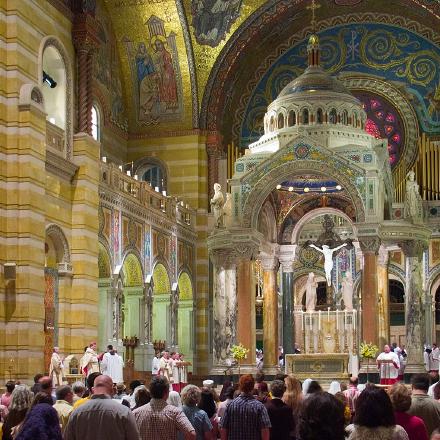
WE ON THE EASTERN Seabord often think that our cities are the last word in ecclesiastical architecture, but Mark Scott Abeln’s splendid ‘Rome of the West‘ site goes a long way towards reminding us of the great physical deposit of Western Civilization and Christian culture situated in the city of St. Louis on the Mississippi River, deep in the heart of America. To show my fellow provincial knickerbockers the richness of St. Louis’s church architecture, I’ve chosen a few photos from Mr. Abeln’s site for posting on this site. A wonderful exhibiton of America’s (which is to say Europe’s) rich cultural heritage.
The jewel in this crown of Catholic Middle America is most certainly the Cathedral Basilica of Saint Louis (above and below). The Cathedral was begun in 1907 and contains the largest collection of mosaic artwork in the world covering 83,000 square feet, the last tesserae of which was installed in 1988. The architecture of the basilica features a number of styles, from the Romanesque Revival exterior to the Byzantine plan and interior, and even contains a chapel designed in the Viennese Reconstructionist style. (more…)
Empire State
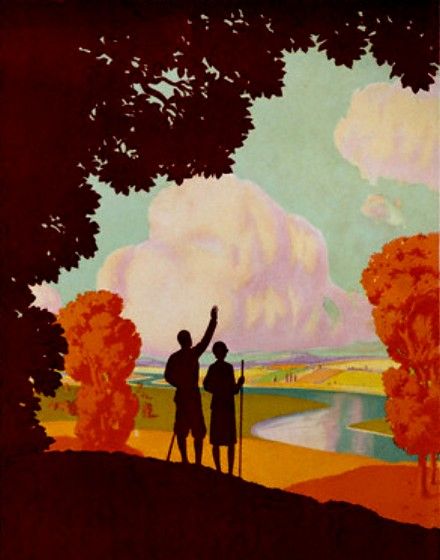
Having been duly capped on the head by the Rt. Hon. Menzies Campbell QC MP with John Knox’s breeks last Thursday I have returned to the land of my birth a Master of the Arts. Details of the various rites and festivities are forthcoming, but in the mean time I share with you these three travel posters from back in the day when they made proper travel posters. All three advertise our blessed Empire State, two of them West Point, the glorious gothic crown of the Hudson. Excelsior!
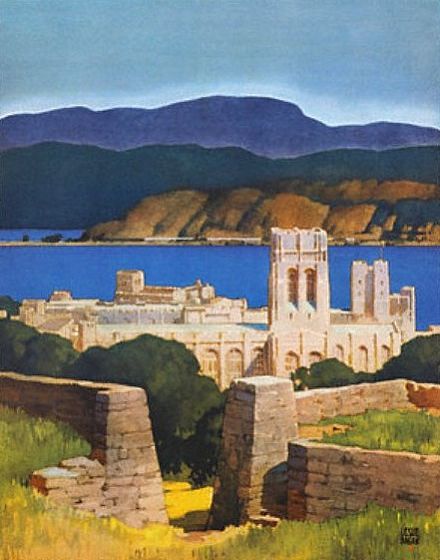
Click on the images for the full posters.
The Perils of Over-Restoration
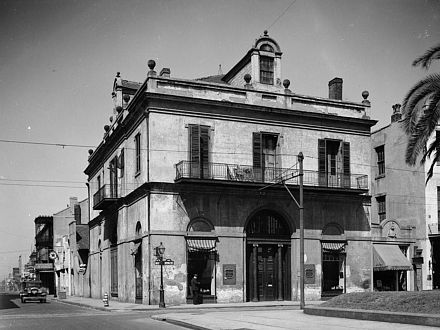
A rather good article I was reading in the Oxford American (via V&V) reminded me of a building I stumbled upon in the Historic American Buildings Survey, digitized at the Library of Congress. No. 403 Royal Street in the French Quarter of New Orleans was designed by one of the first master architects in America, Benjamin Latrobe, who also designed the Baltimore Basilica, the Mother Church of the United States. Resting at the corner of Royal and Conti streets, the building was constructed by the Louisiana State Bank (later subsumed into la Banque de la Louisiane) and features a domed banking hall in the center. After having outlived its usefulness under its original purpose, it became a private residence, with the central banking hall turned into a living room, before being turned into an events venue as it remains today. (more…)
Columbus Circle and the Human Scale
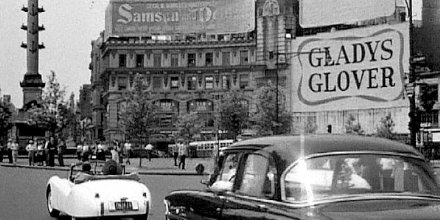
Meandering through the internet yesterday, I came across the above image from the 1954 film ‘It Should Happen to You!’ (via a New York Times article). The film capture shows Columbus Circle in 1954 and was I immediately struck by the superiority of the scale of the buildings to the street, especially compared to today when the Columbus Column is rather overshadowed by the AOL Time Warner Center. It’s not that I don’t like tall buildings; after all New York has some of the most beautiful skyscrapers in the world (though I can’t think of a single great one built after the second war).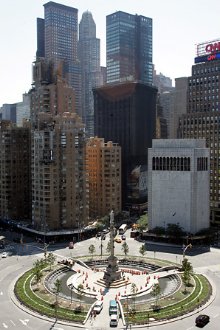 I don’t even object to the residential apartment buildings lining Central Park on Fifth Avenue and Central Park West, except for the fact that on Fifth Avenue they almost always replaced superior, smaller buildings. However, with a public square as small as Columbus Circle, it somehow seems as if lower buildings of only 3-10 storeys would be more appropriate.
I don’t even object to the residential apartment buildings lining Central Park on Fifth Avenue and Central Park West, except for the fact that on Fifth Avenue they almost always replaced superior, smaller buildings. However, with a public square as small as Columbus Circle, it somehow seems as if lower buildings of only 3-10 storeys would be more appropriate.
The latest brouhaha concerns No. 2 Columbus Circle (the shorter, white building in the photo on the right), designed in the early 1960’s by Edward Durell Stone to house the art collection of Huntington Hartford. The current owners want to chic-ify the building by taking off the façade and recladding No. 2 in the more fashionable glass, akin to the neighboring Time Warner Center, and this has roused the ire of many of New York’s preservationist crowd. Though No. 2 has its charms, I’m not a huge fan of the building myself, but the redesign would only make it worse. The chief value of the building is its comparitively low height which, when viewed from the northwest, contributes to the feeling as if the midtown buildings are gradually lowering in height to meet the scale of Columbus Circle. Unfortunately the Time Warner Center doesn’t comply well with this lessening scale, though it at leasts goes through the motions by have a consistent, low base from which its two towers rise. The stone cladding of the Center, however, is rather too dark and gives a slightly gloomy feel to what ought to be a lovely, bright place. (more…)
Search
Instagram: @andcusack
Click here for my Instagram photos.Most Recent Posts
- Amsterdam November 26, 2024
- Silver Jubilee November 21, 2024
- Articles of Note: 11 November 2024 November 11, 2024
- Why do you read? November 5, 2024
- India November 4, 2024
Most Recent Comments
- on The Catholic Apostolic Church, Edinburgh
- on Articles of Note: 11 November 2024
- on Articles of Note: 11 November 2024
- on Why do you read?
- on Why do you read?
- on University Nicknames in South Africa
- on The Situation at St Andrews
- on An Aldermanian Skyscraper
- on Equality
- on Rough Notes of Kinderhook
Book Wishlist
Monthly Archives
Categories

